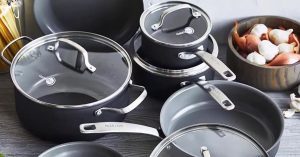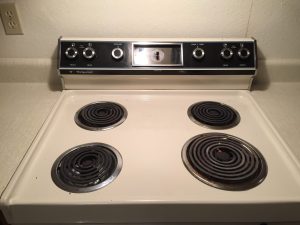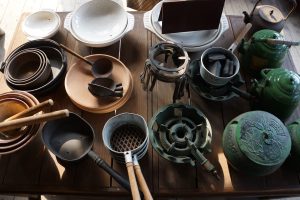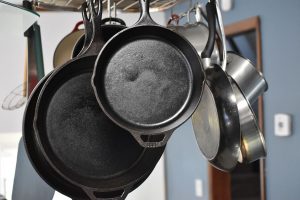Do you know about can ceramic pots and pans be used on electric stoves? When I have to choose pans for my electric stove, it can be confusing because there are so many options available. But I found out that ceramic pots and pans usually work well with most electric stovetops.
To make sure I’m using them correctly, I always read the owner’s guide that comes with my cookware. Ceramic cookware is great because it’s strong, versatile, and lasts a long time.
I can use it not just in the microwave but also on gas stoves and most electric stoves. The best part is that it’s safe to put in my fridge and dishwasher, which makes cleaning up really easy.
Can Ceramic Pots and Pans be Used on Electric Stoves: Yes, ceramic pots and pans are ideal for electric stoves, offering durability and versatility. Always check your cookware’s manual to ensure proper use for longevity and optimal performance.
Quick Navigation
Can Ceramic Pots and Pans be Used on Electric Stoves
Ceramic pots and pans are eco-friendly and safe to use, as they don’t release toxic fumes. They work well on most electric stoves but not on induction stoves that require metal cookware. Consider your stove type before buying ceramic cookware for a seamless cooking experience.
Cooking on Electric Stovetops
Electric stoves can have different types of burners and power levels. Most have raised, flat coils that get hot from electricity. With these and ceramic pots, you don’t need as much heat as with gas stoves.
Some electric stoves have solid disks instead of coils, which are easier to clean because there’s no place for mess to get stuck. But, if you’re using ceramic pots on these, your food might take longer to cook because these disks don’t heat up as fast as coils.
Electric Stovetops with Glass Surfaces
Glass-topped electric stoves, also known as flat-topped stoves, have burners hidden under a flat glass layer. You’ll see a drawing or colored ring showing where the burner is.
You can use ceramic pots on these stoves, but you need to be careful because they can scratch the glass. So, never drag the pot across the stove. Pots with grooves or a textured bottom may not heat up evenly on these stoves, so it’s best to use flat-bottomed ceramic pots.
Induction Cooktop
You can’t use ceramic pots on induction stoves. These stoves need pots made from stainless steel or iron. Pots made from ceramic, glass, aluminum, or copper can’t spread the heat from an induction stove properly.
Unlike other stoves that just heat up the coil or disk under the pot, an induction stove works with the metal pot to cook the food. So, ceramic pots won’t work on an induction stove.
Points to Ponder for Ceramic Cookware Selection
Ceramic pots are tough, but if you’re not careful, they can break or chip. Keep them separate from your metal pots and pans.
Just like any pot, ceramic pots get hot and can burn you, so always use oven mitts when they’re hot. Brands like Emile Henry can handle up to 480 degrees Fahrenheit.
When you take a hot ceramic pot off the stove, put it on a trivet, a hot pad, or a folded towel to protect your table or counter. And for the best cooking, always put food in the pot before you start heating it up.
Ceramic Withstands Heat
Ceramic pots can handle really high heat – even up to 850 degrees Fahrenheit. That means you can use them on almost any stove where you’d use a metal pot.
But because they’re not metal, they won’t work on induction stoves since they need a magnetic field to heat up. Also, be careful not to drag them on a glass-top stove because they can scratch the surface, as warned by GE Appliances.
Benefits of Using Ceramic Cookware on Electric Stoves
There are several benefits to using ceramic cookware on electric stoves:
- Heat Distribution: Ceramic pots and pans evenly distribute heat across their surface, ensuring your food cooks consistently.
- Non-Stick: Many ceramic cookware pieces have a naturally non-stick surface, which means you can use less oil or butter in your cooking, making your meals healthier.
- Heat Retention: Ceramic retains heat well, keeping your food warm even after you’ve turned off the stove.
- Versatility: You can use ceramic cookware in the oven, microwave, and dishwasher, and it’s safe to store in the refrigerator.
- Easy to Clean: Ceramic cookware’s non-stick surface makes it easy to clean. Most pieces are also dishwasher-safe.
- Durable and Long-Lasting: Ceramic cookware is tough and resistant to scratches and chips, meaning it can last for years if properly cared for.
- Eco-Friendly: Ceramic cookware is made from all-natural, inorganic materials, making it an environmentally friendly choice.
- Aesthetically Pleasing: Ceramic cookware comes in various colors and designs, adding a touch of elegance to your kitchen.
Precautions and Guidelines for Using Ceramic Cookware on Electric Stoves
Here are some tips and precautions for using ceramic cookware on electric stoves:
- Compatibility Check: Ensure your ceramic cookware is suited for your electric stove.
- Moderate Heat Use: Stick to medium heat settings to avoid damage to the ceramic over time.
- Potholder Usage: Use oven mitts or potholders when handling hot ceramic cookware for safety.
- Avoid Dragging: Lift your cookware when using glass-top stoves to prevent scratching.
- Flat-Bottomed Preference: Choose flat-bottomed ceramic cookware for even heating on electric stoves.
- Gentle Handling: Ceramics can chip or break upon impact; handle with care.
- Cool Before Washing: To avoid thermal shock, allow your cookware to cool before washing.
- Induction Stove Limitation: Ceramic cookware isn’t compatible with induction stoves that need metal cookware.
FAQs:
Q:1 Which pots are most suitable for an electric stove?
Optimal cookware for electric stoves should be durable, resilient, and resistant to scratching. Stainless steel, copper, cast iron, and aluminum are recommended. Ceramic and glass cookware are typically less effective on electric stoves.
Q:2 Is it safe to use ceramic cookware on a glass-top stove?
True ceramic cookware, with its rough texture, is not advised for glass-top stoves due to potential surface damage. However, most “ceramic” products sold today are actually metal with a silicone nonstick coating, not true ceramic.
Q:3 Can conventional pots and pans be used on an electric stove?
Regular cooking pots are generally not recommended for electric stoves. Opt for stainless steel or carbon steel cookware instead.
Conclusion:
In conclusion, ceramic pots and pans can generally be used on electric stoves with great success. They offer durability, versatility, and even heat distribution. However, it’s important to ensure compatibility by referring to the manufacturer’s guidelines.
Ceramic cookware is not suitable for induction stovetops due to its lack of magnetic properties. Additionally, care should be taken to avoid scratching glass-top electric stoves, and flat-bottomed ceramic cookware is recommended for optimal heat transfer.
With proper precautions and adherence to recommended usage, ceramic cookware can be a reliable and enjoyable choice for cooking on electric stoves.
We trust that this detailed article has provided you with a clear understanding of whether can ceramic pots and pans be used on electric stoves. If you have any queries, please don’t hesitate to leave a comment below!




